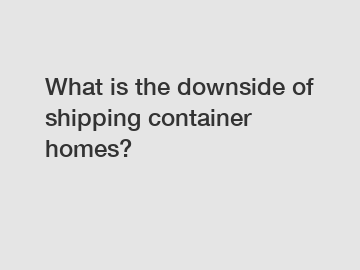What is the downside of shipping container homes?
Shipping container homes have gained popularity in recent years for their affordability and sustainability. These homes, built from repurposed shipping containers, have become a trendy housing option for those seeking a unique and eco-friendly living space. However, like any other alternative housing solution, there are downsides to consider. In this article, we will explore the potential disadvantages of shipping container homes.
1. Limited Space and Design Constraints.
One of the major downsides of shipping container homes is their limited space and design constraints. Shipping containers come in standard sizes, with the most common being 20 or 40 feet long. While this may be sufficient for some people, it can be quite restrictive for those who desire a spacious and customized living area. It can be challenging to create functional rooms within the narrow dimensions of a shipping container, and creative solutions are often required to maximize every inch of space.

2. Insulation and Temperature Control.
Another drawback of shipping container homes is their insulation and temperature control. Metal containers are not naturally insulated, meaning they can become uncomfortably hot during summer months and frigidly cold in winter. While it is possible to add insulation to the containers, it can be a costly and time-consuming process. Additionally, ensuring proper ventilation and airflow can be challenging, further exacerbating the temperature control issues.
3. Structural Modifications and Regulations.
When transforming a shipping container into a home, structural modifications are often required. This may involve cutting openings for windows and doors, reinforcing the container, and adding additional support for roof loads. However, these modifications can weaken the structural integrity of the container if not done correctly, potentially compromising the safety of the inhabitants. It is crucial to ensure compliance with local building codes and regulations, which can further increase the construction cost and time.
4. Limited Availability and Accessibility.
Although shipping container homes have gained popularity, finding suitable containers to convert can be challenging. The demand for repurposed shipping containers has increased, leading to limited availability and higher prices. Additionally, the cost of transporting containers to the desired location can be significant, particularly if the site is in a remote area. This lack of accessibility and increased transportation costs can add to the overall expenses of building a shipping container home.
5. Limited Resale Value.
One aspect that potential buyers should consider is the limited resale value of shipping container homes. While they may be a trendy and cost-effective housing solution at present, it is uncertain how their value will hold up in the long term. The niche appeal of container homes may limit their marketability, making it challenging to sell the property if desired in the future.
In conclusion, while shipping container homes offer an affordable and sustainable housing option, there are several downsides to consider. The limited space and design constraints, insulation challenges, structural modifications, limited availability and accessibility, as well as the uncertain resale value, are all factors to take into account before undertaking such a project. It is essential to thoroughly research and weigh the pros and cons before diving into the world of shipping container homes.
If you have any questions or would like further information about shipping container homes, please do not hesitate to contact us.
For more information, please visit Container House Expandable, Expandable Container House Price, Custom Granny Flat Container.
284
0
0

Comments
All Comments (0)